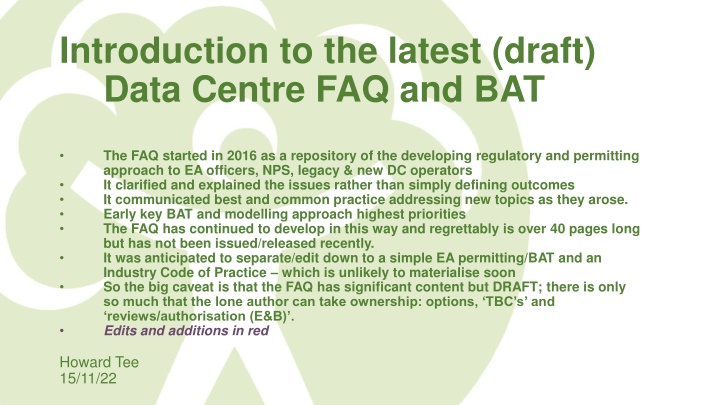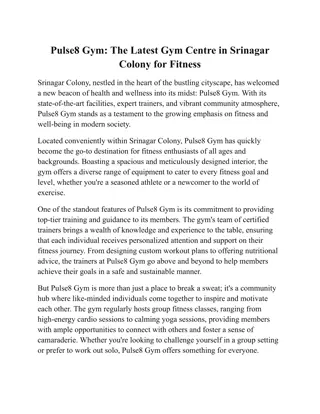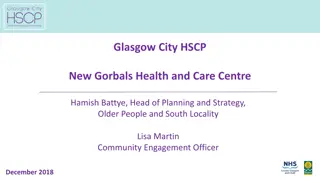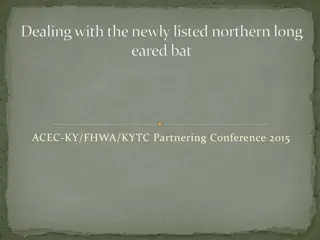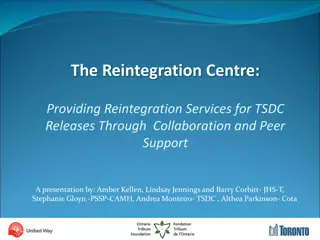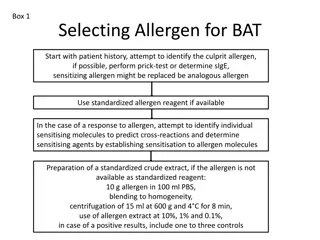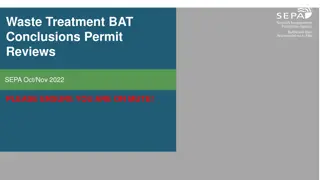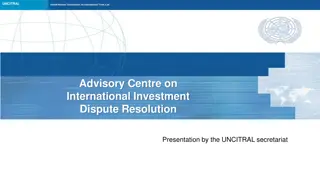Latest Developments in Data Centre FAQ and BAT
The latest draft Data Centre FAQ and BAT provide key updates and additions focusing on topics such as temporary plant usage, commissioning definitions, emissions optimization, waste codes for reporting, and more. Moving towards using SCR as BAT highlights the industry's shift towards larger, more efficient builds with increased environmental considerations and operational flexibility.
Download Presentation

Please find below an Image/Link to download the presentation.
The content on the website is provided AS IS for your information and personal use only. It may not be sold, licensed, or shared on other websites without obtaining consent from the author.If you encounter any issues during the download, it is possible that the publisher has removed the file from their server.
You are allowed to download the files provided on this website for personal or commercial use, subject to the condition that they are used lawfully. All files are the property of their respective owners.
The content on the website is provided AS IS for your information and personal use only. It may not be sold, licensed, or shared on other websites without obtaining consent from the author.
E N D
Presentation Transcript
Introduction to the latest (draft) Data Centre FAQ and BAT The FAQ started in 2016 as a repository of the developing regulatory and permitting approach to EA officers, NPS, legacy & new DC operators It clarified and explained the issues rather than simply defining outcomes It communicated best and common practice addressing new topics as they arose. Early key BAT and modelling approach highest priorities The FAQ has continued to develop in this way and regrettably is over 40 pages long but has not been issued/released recently. It was anticipated to separate/edit down to a simple EA permitting/BAT and an Industry Code of Practice which is unlikely to materialise soon So the big caveat is that the FAQ has significant content but DRAFT; there is only so much that the lone author can take ownership: options, TBC s and reviews/authorisation (E&B) . Edits and additions in red Howard Tee 15/11/22
Key Updates & Additions 1. Use of temporary plant large scale needs added AQ risk assessment 2. Definition of Commissioning for (in advance) permitting 3. Expanding sites >50MWth permitted as new MCP initially BAT expectations 4. Maintenance regime for optimum emissions anymore suggestions? 5. Implications if Main power source not UKPN (landfills, EfW, solar panels) for contracting back on to Grid in an outage, reliability & probability of outages impacting AQ model 6. Clarity around 2g-Luft & EPA tier2 emissions optimised: tolerances 7. Propose consideration that BAT for commissioning new engines is a sample port confirming BAT emissions (2g/EPA Tier2)
Key Updates & Additions 8. Using SCR to achieve 2g-Luft & EPA tier2 emissions optimised Equivalence (Full and Lite SCR defined) 9. Waste EWC codes listed and expected for Annual Reporting (Pollution Inventory) 10.AQ modelling advice & outcomes inc completing the goals of the AQMP template 11.Good practice issues (but not strictly DAAs) coming up in inspections that might affect sites? 12.General agreement retro-fitting sample ports and doing ELV compliance not appropriate for standby overall. 13.HVO 14.SCR as BAT (Separate SCR BAT document in draft) (Other stuff hidden in the now 42 page document!!!)
Moving to SCR as BAT 1. Sector is expanding rapidly with significant balance change from legacy to new build since 2017 2. New builds are getting bigger (MWth) with still larger engines 3. Expansion options for mega-scale (hyperscale) including buying up adjacent land after permitting 4. Increased awareness for receptors high peak NO & NO2 5. Increased operator awareness for workplace potential exposure during outages peak NO2 6. Sites fitting SCR abatement under planning in GLA for long term environmental costs (Air Quality Focus Areas AQFAs, Air Quality Neutral) 7. Under a Corporate precautionary & Green objectives basis for some operators 8. Clusters and associated concerns are increasing (sites permitted/assessed separately till now) for wider outages 9. Possible Options to increase pool of available new engines (marginally non-emission optimised ) to allow more flexibility tolerances on 2g/EPA Tier2 BAT with SCR to achieve equivalence i.e. buying do better SCR than the minimum as a package? 10.Future options to see the standby diesel sector as an elective emergency resource
Moving to SCR as BAT The following points are noted for information: SCR is commonly regarded and taken to be the BAT secondary abatement option for diesel engines for NOx (without further justification in the FAQ not least because ) The MCP legal requirement ELV for diesel engines, new and existing plant >5MWth on gas- oil is 190mg/m3 at 15% O2 * (250mg/m3 for existing plant <5MWth) The exclusion from the above ELV is under Article6(8) Member states may exempt new MCP which to not operate >500hours per year Engine BAT already assumes BAT for Stacks and BAT of having an AQMP Upshot: The EA is wishing to move to SCR as BAT under the review cycle of BAT for IED 1.1A(1)a large aggregated standby but under detailed, applicable criteria as follows. *this ELV itself could be even tighter in AQMAs under MCP Article6(9)
Criteria 1) Emissions optimised 2g-TA Luft or US EPA tier 2 or equivalent the current default BAT 2) Outage ambient NOx peak limited & minimised due to scale or location/proximity of standby; or technically where the Peak NOx over short timescales (first 10mins to few hours) to sensitive receptors could hence not reasonably be managed via the AQMP: In any event (new or existing plant expanding aggregated}, plant fitted with SCR (full or lite etc) to all or most engines and abated to at least a level whereby no current or likely future sensitive receptor under outage for the whole or part site realistic loads peak NO or NO2 (NOx) exceeds a defined safe concentration limit what is the safe limit TBC*? Target 99.7%ile 1 hour average off-site (cell max, any potential receptor) NO2 <600ug/m3 or better Absolute theoretical peak 100%ile on/off site AEGL1 (nearly =HSE Workplace exposure) NO2 940ug/m3 (being common concentration - 10min to 8hour value) {site specific justification of the averaging period based on ability to proactively engage AQMP with receptors precautionary default 10mins, but consider 1hour} * Based on DEFRA Air Quality Index (see BreatheLondon) with an absolute peak: 1304251155_Update_on_Implementation_of_the_DAQI_April_2013_Final.pdf (defra.gov.uk)
Criteria 3) Local Authority or regionally designated AQF, AQMPs, planning requirement and possibly designated clusters (notably Slough Trading Estate) heightened BAT SCR-full+: Emissions optimised (2g/US EPA tier2) engines fitted with fast-response (<=10mins) full-SCR abatement achieving better than 90% reduction (ideally to at least an indicative 95mg/m3 at 15% O2) 4) ADVISORY BAT SCR-ready configurations are included to allow retrospective fitting of SCR abatement if necessary SCR-Lite = 2g/US EPA tier2 equivalence (750mg/m3 at 15% O2) SCR full = MCP ELV compliance (190mg/m3 at 15% O2) SCR full+ = 2g/ US EPA tier2 + with fast-response maximal SCR (<95mg/m3 at 15% O2) [risks NH3 slip issues?] Of currently 22 HNL permitted aggregated standby I reckon 4 would probably need some SCR, 15 maybes (so more detailed AQ remodelling at least), 7 unlikely
Notes This is about de-linking likelihood of a prolonged outage to one of in the event of any reasonable outage (or in some cases maintenance/tests too) operations, where, when and for how long could short peak NO2 (and NO) occur. This is looking at the process contribution PC/PEC and ultimately this may be equivalent to a site total mass emission rate (MWth density) - TBC It is generally recognised and currently permitted that achieving ST ambient AQ standard of <200ug/m3 at any location off-site for around 1 hour (let alone in a prolonged outage <18hours) for even some of the smallest aggregated sites (MCP scale) could be unachievable and disproportionate for reliably connected, emergency standby in urban settings. But ultimately this is the idealised target DAQI level for no pollution. EA specified generator modelling guidance: You need to include the maximum hourly (100th percentile) NO2PEC. This is to understand the potential health effects and the amount of risk to members of the public. There is no absolute hourly limit environmental standard for the acute exposure to NO2, but there can be effects on health over a certain threshold .
Review cycle of BAT (4-8 years) for IED 1.1A(1)a >50MWth for Aggregated Standby A. 2025 Criteria defining when SCR as BAT applies (i.e. over emissions optimised plant) new plant Agree SCR BAT for new plant and if needed CBA criteria for existing plant Technical aspects and operational BAT of SCR on diesel standby Opportunity for review of the FAQ of sector critical aspects of BAT (pick out anything for discussion, clarity or expansion generally industry code of practice ICOP?) Scope for future proofing BAT beyond 2030 Start reviewing existing stock of permits under a BAT review B. 2026 Completed review of 1.1A(1)a aggregated standby (includes some non-data centres) C. 2030 End of Four year period to implement BAT across the sector
SCR as BAT for New:- the advantages Or put another why not start planning on fitting SCR just now? Permitting on AQ should be easier for new plant? Precautionary principle for future expansion and clusters Clear benefit on short term peaks and overall AQ LT impacts AQ environment is improving so unabated diesel standby will become a larger, more obvious source after 2030 (when current investments may still have 20+years) Secondary benefits TBC could the sector agree an approach to allow UK identified emergency/resilience criteria i.e. sites with SCR might be allowed to do demand-side response or limited export (but avoiding/incorporating a limited specified generator component)?
